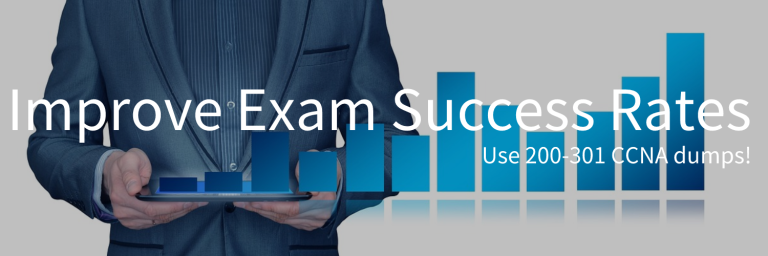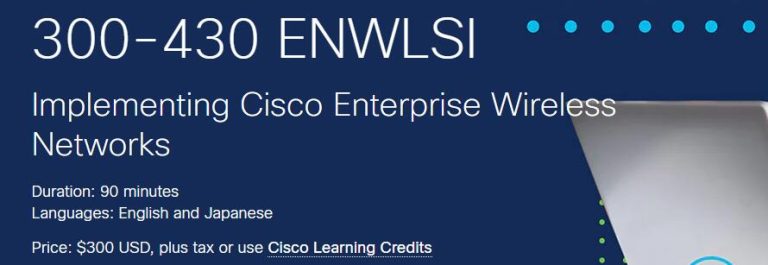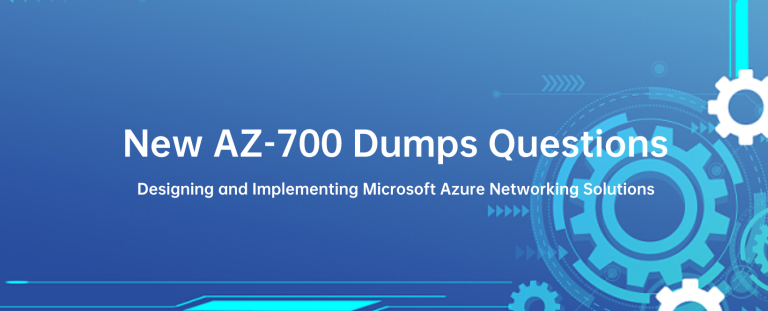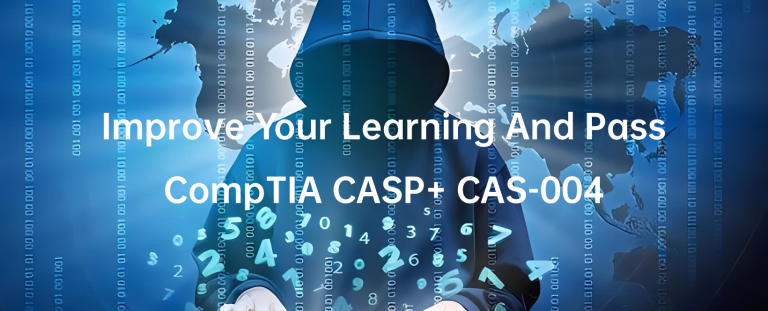Why Passing Cisco 300-115 dumps can be worthy? “Implementing Cisco IP Switched Networks (SWITCH v2.0)” is the name of Cisco 300-115 exam dumps which covers all the knowledge points of the real Cisco exam. Most accurate CCNP Switch 300-115 dumps pdf questions with latest version pdf&vce youtube study. Pass4itsure 300-115 dumps exam questions answers are updated(437 Q&As) are verified by experts.The associated certifications of 300-115 dumps is CCDP. Passing the Cisco exam is not a big deal because of the authentic CCNP Routing and Switching https://www.pass4itsure.com/300-115.html dumps study guides material. It is available online very easily with other vital Cisco dumps.
Exam Code: 300-115
Exam Name: Implementing Cisco IP Switched Networks (SWITCH v2.0)
Updated: Sep 05, 2017
Q&As: 437
[New Cisco 300-115 Dumps Release From Google Drive]: https://drive.google.com/open?id=0BwxjZr-ZDwwWLW41Sk5QSDdPTFU
[New Cisco 200-155 Dumps Release From Google Drive]: https://drive.google.com/open?id=0BwxjZr-ZDwwWNHFtR0VqbXVEeUU
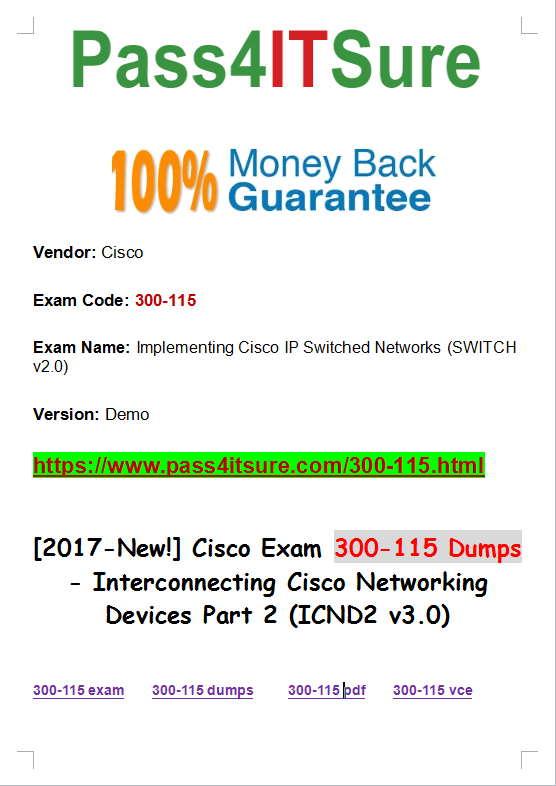
Pass4itsure Cisco 300-115 Dumps Training Program Online Here
Question Set 1
QUESTION 1
What is the maximum number of switches that can be stacked using Cisco StackWise?
A. 4
B. 5
C. 8
D. 9
E. 10
F. 13
300-115 exam Correct Answer: D
Explanation
Explanation/Reference:
Explanation:
Up to 9 Cisco Catalyst switches can be stacked together to build single logical StackWise switch since Cisco IOS XE Release 3.3.0SE. Prior to Cisco IOS XE
Release3.3.0SE, up to 4 Cisco Catalyst switches could be stacked together.
QUESTION 2
A network engineer wants to add a new switch to an existing switch stack. Which configuration must be added to the new switch before it can be added to the 300-115 dumps switch stack?
A. No configuration must be added.
B. stack ID
C. IP address
D. VLAN information
E. VTP information
Correct Answer: A
Explanation
Explanation/Reference:
Explanation:
Switch Stack Offline Configuration
You can use the offline configuration feature to provision (to supply a configuration to) a new switch before it joins the switch stack. You can configure in advance
the stack member number, the switch type, and the inter- faces associated with a switch that is not currently part of the stack. The configuration that you create on
the switch stack is called the provisioned configuration . The switch that is added to the switch stack and that re- ceives this configuration is called the provisioned
switch .
You manually create the provisioned configuration through the switch stack-member-number provision type global configuration command. The provisioned
configuration is automatically created when a switch is added to a switch stack and when no provisioned configuration exists.
When you configure the interfaces associated with a provisioned switch (for example, as part of a VLAN), the switch stack accepts the configuration, and the
information appears in the running configuration. The interface associated with the provisioned switch is not active, operates as if it is administratively shut down,
and the no shutdown interface configuration command does not return it to active service. The interface associated with the provisioned switch does not appear in
the display of the specific feature; for example, it does not appear in the show vlan user EXEC command output.
The switch stack retains the provisioned configuration in the running configuration whether or not the provi- sioned switch is part of the stack. You can save the
provisioned configuration to the startup configuration file by entering the copy running-config startup-config privileged EXEC command. The startup configuration
file ensures that the switch stack can reload and can use the saved information whether or not the provisioned switch is part of the switch stack.Effects of Adding a Provisioned Switch to a Switch Stack
When you add a provisioned switch to the switch stack, the stack applies either the provisioned configuration or the default configuration. Table 5-1 lists the events that occur when the switch stack compares the provisioned configuration with the provisioned switch.Table 5-1 Results of Comparing the Provisioned Configuration with the Provisioned Switch
Scenario Result The stack member num- 1. If the stack member number The switch stack applies bers and the switch types of the provisioned switch the provisioned configura match. matches the stack member num- tion to the provisioned ber in the provisioned configura- switch and adds it to the tion on the stack, and stack.
2. If the switch type of the provisioned switch matches the switch type in the provisioned configuration on the stack.
The stack member num- 1. If the stack member number The switch stack applies bers match but the switch of the provisioned switch the default configuration to types do not match. matches the stack member num- the provisioned switch and ber in the provisioned configuration on the stack, but adds it to the stack.
2. The switch type of the provi- The provisioned configura- sioned switch does not match the tion is changed to reflect switch type in the provisioned the new information.configuration on the stack.The stack member num- The switch stack appliesber is not found in the pro- the default configuration tovisioned configuration. the provisioned switch and adds it to the stack.The provisioned configuration is changed to reflect the new information. The stack member num- The stack master assigns a new The switch stack applies ber of the provisioned stack member number to the pro- the provisioned configura- switch is in conflict with an visioned switch. tion to the provisioned existing stack member. switch and adds it to the The stack member numbers and stack. the switch types match: The provisioned configura-
1. If the new stack member
tion is changed to reflect
number of the provisioned switch
the new information.
matches the stack member num
ber in the provisioned configura
tion on the stack, and
2. If the switch type of the provi
sioned switch matches the switch
type in the provisioned configura
tion on the stack.
The stack member numbers The switch stack applies
match, but the switch types do the default configuration to not match: the provisioned switch and
adds it to the stack.
1. If the stack member number
of the provisioned switch The provisioned configura
matches the stack member num- tion is changed to reflect
ber in the provisioned configura- the new information.
tion on the stack, but
2. The switch type of the provi
sioned switch does not match the
switch type in the provisioned
configuration on the stack.
The stack member num- The switch stack applies
ber of the provisioned the default configuration to
switch is not found in the the provisioned switch and
provisioned configuration. adds it to the stack.
Reference:
QUESTION 3
What percentage of bandwidth is reduced when a stack cable is broken?
A. 0
B. 25
C. 50
D. 75
E. 100
300-115 pdf Correct Answer: C
Explanation
Explanation/Reference:
Explanation:
Physical Sequential Linkage
The switches are physically connected sequentially, as shown in Figure 3. A break in any one of the cables will result in the stack bandwidth being reduced to half
of its full capacity. Subsecond timing mechanisms detect traffic problems and immediately institute failover. This mechanism restores dual path flow when the
timing mechanisms detect renewed activity on the cable.
Figure 3. Cisco StackWise Technology Resilient Cabling
QUESTION 4
Refer to the exhibit.
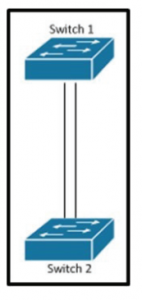
Which set of configurations will result in all ports on both switches successfully bundling into an EtherChannel?
A. switch1
channel-group 1 mode active
switch2
channel-group 1 mode auto
B. switch1
channel-group 1 mode desirable
switch2
channel-group 1 mode passive
C. switch1
channel-group 1 mode on
switch2
channel-group 1 mode auto
D. switch1
channel-group 1 mode desirable
switch2
channel-group 1 mode auto
300-115 vce Correct Answer: D
Explanation
Explanation/Reference:
Explanation:
The different etherchannel modes are described in the table below:
Mode Description
active Places an interface into an active negotiating state, in which the interface starts negotiations with other interfaces by sending LACP packets.
auto Places an interface into a passive negotiating state, in which the interface re- sponds to PAgP packets it receives but does not start PAgP packet negotia
tion. This setting minimizes the transmission of PAgP packets.
desirable Places an interface into an active negotiating state, in which the interface starts negotiations with other interfaces by sending PAgP packets.
on Forces the interface into an EtherChannel without PAgP or LACP. With the on mode, a usable EtherChannel exists only when an interface group in the on
mode is connected to another interface group in the on mode.
passive Places an interface into a passive negotiating state, in which the interface re- sponds to LACP packets that it receives, but does not start LACP packet ne
gotiation. This setting minimizes the transmission of LACP packets.
Both the auto and desirable PAgP modes allow interfaces to negotiate with partner interfaces to determine if they can form an EtherChannel based on criteria such
as interface speed and, for Layer 2 EtherChannels, trunking state and VLAN numbers.
Interfaces can form an EtherChannel when they are in different PAgP modes as long as the modes are compatible. For example:
An interface in the desirable mode can form an EtherChannel with another interface that is in the desirable or auto mode.
An interface in the auto mode can form an EtherChannel with another interface in the desirable mode.
An interface in the auto mode cannot form an EtherChannel with another interface that is also in the auto mode because neither interface starts PAgP negotiation.
An interface in the on mode that is added to a port channel is forced to have the same characteristics as the already existing on mode interfaces in the channel.
5.Consider an information system of a Pay-Tv company based on a SOA architecture.
The integrated system currently consists of three core systems:
– a CRM (Customer Relationship Management) system
– a BRM (Billing and Revenue Management) system
– a CAS (Conditional Access System) system all of them communicating with SOA Middleware.
You have been asked to manage the testing activities for the integration of two additional off-the-shelf
systems from two different vendors: a SMS (Short Message Service) server and an IVR (Interactive Voice
Response) system.
Assume that there is a high likelihood that the two off-the-shelf systems will be low-quality and that you
have a clear proof that the testing performed by the two vendors on their systems has been unsystematic
and unprofessional. This obviously leads to higher quality risk for the overall integrated system.
You are the Test Manager of this project. Your main goal is to plan for testing activities to mitigate this risk.
Which of the following answers best describes the test activities (assuming it is possible to perform all of
them) you should plan for?
K4 3 credits
A. You should plan for an informal and minimal acceptance test of the two off-the-shelf systems and then
a single end-to-end test of the overall integrated system
B. You should directly plan for a single end-to-end test focused on end-to-end tests of the overall
integrated system without an acceptance test of the two off-the-shelf systems
C. You should plan for two levels: a system integration test and an end-to-end test of the overall
integrated system
D. You should plan for adequate re-testing of both the systems followed by a system integration test and
an end-to-end test of the overall integrated system
300-115 exam Answer: D
6.The following are the exit criteria described in the test plan of a software product:
EX1. The test suite for the product must ensure that at least each quality risk item is covered by at least
one test case (a quality risk item can be covered by more test cases).
EX2. All test cases in the test suite must be run during the execution phase.
EX3. Defects are classified into two categories: C (critical defect) and NC (non-critical defect). No
known C defects shall exist in the product at the end of the test execution phase.
Which of the following information is useless when the specified exit criteria is evaluated?
A. A traceability matrix showing the relationships between the product risk items and the test cases
B. A list of all the open defects with the associated classification information extracted from the defect
tracking system
C. A chart, showing the trend in the lag time from defect reporting to resolution, extracted from the defect
tracking system
D. The execution status of all the test cases extracted from the test management tool
300-115 dumps Answer: C
7.Which of the following is an example of the test closure activity indicated as “lessons learned”?
A. Archive all the test results of the acceptance testing phase
B. Deliver a list of the open defects of a software product released into production to the service desk
team
C. Participate in a meeting at the end of a project aimed at better managing the events and problems of
future projects
D. Deliver an automated regression test suite, used during the system test phase of a software product
released into production, to the team responsible for maintenance testing
Answer: C
8.Assume that you are the Test Manager for a small banking application development project.
You have decided to adopt a risk-based testing strategy and 5 product risks (R1, R2, R3, R4, and R5)
have been identified during the quality risk analysis.
The following table shows the risk level associated to these product risks (higher numbers mean higher
risk):
55 test cases have been designed and implemented to cover all these 5 product risks. The coverage is
described in a traceability matrix.
This is the test execution status table, after the after the first week of test execution:
About 56% of the planned test cases have been successfully executed.
Assume that no additional product risks have been identified during the first week of test execution.
Which of the following answers would you expect to best describe the residual risks associated with the
identified product risks, at the end of the first week of test execution?
A. Since R3 is the only risk for which all test cases have passed, the risk has been reduced by 20%
B. The test execution status table indicates that the risk has been reduced by 56%
C. The residual risk level can t be determined, because it requires that all the test cases have been
executed
D. The test execution table doesn t give an indication of the risk level of the open defects and the test
cases that failed or are not run yet
Answer: D
The online Implementing Cisco IP Switched Networks study guides strive for excellence and the website offers all the features of a good study material of 300-115 dumps real exam Questions. Candidates can easily avail the Download 300-115 dumps. The use of the Cisco https://www.pass4itsure.com/300-115.html dumps is very effective and greatly helpful in increasing the CCNP Routing and Switching skills among the students.
